Ground-dwelling forest birds are always hard to see throughout
Southeast Asia and it is no different in Thailand. Galliformes,
which include partridges, pheasants, peacock pheasants and
junglefowl, can be hard to observe as they are not only frequently
shy but have often been pushed close to extinction through
habitat destruction and hunting. Indeed, the fact that these
birds are so obviously a good source of food, not only to
humans but also to forest predators, almost certainly goes
a long way to explaining why they are shy birds that are hard
to observe. However, it is also true that these species can
become habituated to visiting areas in close proximity to
humans when there is a food source present. The best example
of this is the ancestor of domestic chickens, Red Junglefowl,
which surely became habituated to feeding on scraps of food
left by humans thousands, of years ago.
Kaeng Krachan national park, in Western Thailand, has long
been famous among birders as a location where a variety of
species in this group occur but apart from Red Junglefowl,
most of the species in this fantastic area have been very
hard to see. However, with the advent of a number of hides
overlooking small, man-made waterholes where food is also
supplied, a number of these birds have become far more frequently
encountered by birders, although a couple of rare species
are so seldom-seen they retain near mythical status.
While it is always thrilling to come across pheasants and
partridges when birding in the forest, the hides around the
edges of the park allow for some truly amazing views of these
birds, making for some great photo opportunities and memories.
The book Pheasants,
Partridges and Grouse of the World deals with identifying
and the ecology of these birds but on this page I will talk
about which species can be seen in the vicinity of Kaeng Krachan
national park and how often they are encountered.
Bar-backed Partridge Arborophila
brunneopectus
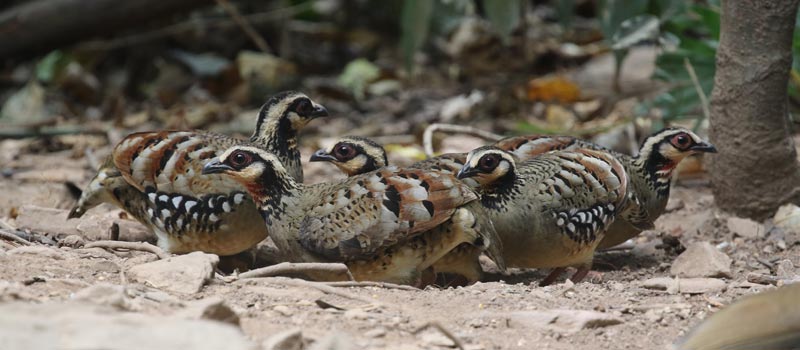
When I first started birdwatching in Thailand Bar-backed
Partridge was a bird that I very rarely saw. The most reliable
location for finding this species was Nam Nao National Park
where I frequently saw them on the loop trail at headquarters.
The other location I sometimes saw this attractive bird was
the higher parts of Kaeng Krachan National Park, particularly
the area around kilometre 27 and sometimes behind the kitchen
at Panoen Tung. However, these birds were always shy and it
was hard to get a good view with photography more or less
impossible and viewing them as part of a group of birders
was extremely challenging. With observations being more or
less restricted to those locations, in the vicinity of 700
metres and above, I associated this species with this type
of altitude. It was a real surprise to me then when I learned
that they were regularly coming to feed at Baan Song Nok,
outside of the national park at low altitude.
Over the intervening years many birders have enjoyed watching
and photographing this beautiful partridge at Baan Song Nok
which remains more or less the most reliable spot for this
species. However, inspired by the success of the feeding area
at Baan Song Nok a number of other similar waterholes and
hides have popped up around the edges of Kaeng Krachan, some
of which attract Bar-backed Partridges on a fairly regular
basis. Both Lung Sin waterhole and Daap 2 waterhole quite
often attract this bird, particularly when conditions are
dry, coming to drink from the water hole and frequently feeding
on the food provided.
Of course Bar-backed Partridge is often heard calling from
the forest before they are seen at the waterholes and far
more frequently heard in the national park than the bird is
seen; their song is really interesting. Listen to the call
of Bar-backed Partridge.
Normally when they first approach the open areas in which
all of these waterholes are situated, these partridges behave
nervously and are skittish, scared off back into the undergrowth
by sharp sounds or movements, but once they have emerged and
have started feeding they become fairly oblivious to minor
disturbances. Bar-backed Partridge is definitely one of the
more attractive galliformes that can be seen in this area,
in my opinion, and always a highlight of a session in one
of the hides in the Kaeng Krachan area.
Green-legged (Scaly-breasted) Partridge
Arborophila chloropus
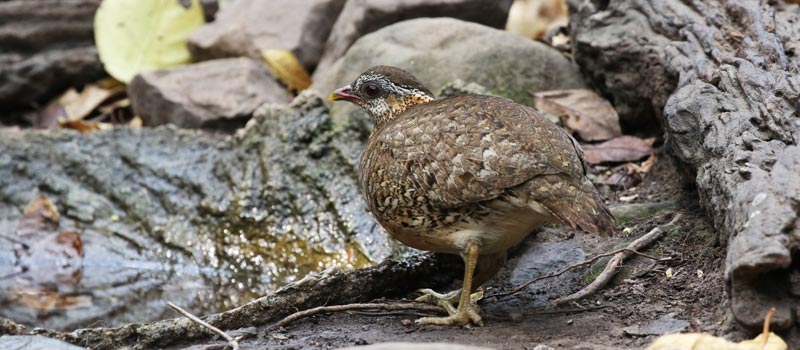
For birders in Thailand if they have an encounter with a
forest partridge then most commonly it will be with this species.
Green-legged Partridge is fairly abundant in the two most
visited national parks for birders within reach of Bangkok;
Khao Yai and Kaeng Krachan. While this may be a widespread
bird by its nature it is still a shy species, it is just that
it is common enough that if birders spend long enough in the
forest they will eventually happen upon one. However, seeing
one in the undergrowth or getting a glimpse as it crosses
a forest trail is oen thing but observing a pair of these
intricately-plumaged bird as they strut around in the open
at one of the hides near Kaeng Krachan is another thing indeed.
Green-legged Partridge used to be known as Scaly-breasted
Partridge. Those who do the naming decided that the breast
was not scaly or that the name confused this species with
others but considering that they do not have green legs it
seems to be just another confusing example of renaming of
a bird. I am not sure what the point was. As with other species
on this list this partridge is likely to be heard before it
is seen and the song is an interesting duet. Listen to the
call
of Green-legged Partridge.
There are a growing number of hides at waterholes around
Kaeng Krachan and most of them are visited by Green-legged
Partridge on a fairly regular basis. They are most reliably
seen in the driest times but I have also seen them coming
for food in the wet season; they obviously become habituated
to the food that is put out at the most frequently-watched
waterholes; Lung Sin and Baan Song Nok. In the past there
used to be a stakeout at Bang Krang campsite at kilometre
15 in the national park but this is no longer active due to
layout changes there. These days the best chance of watching,
photographing and filming this species is at one of the hides.
Ferruginous Partridge Caloperdix
oculeus
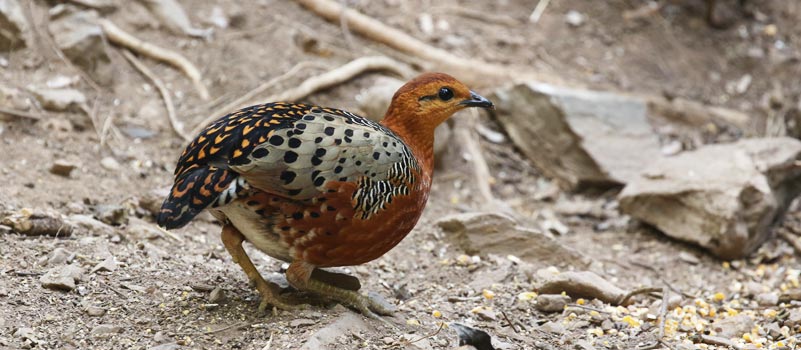
Ferruginous Partridge is a scarce bird wherever it occurs
and few people are lucky enough to see it when birding in
the forest. I had been visiting Kaeng Krachan for some years
without hearing of anyone seeing these birds when one day
I was trying to see what was making a scratching sound on
the forest floor when one stunning Ferruginous Partridge came
out from where I could hear it and crossed the road just a
few metres away from me. This sighting confused me for a little
while as the bird was far more attractive with plumage much
more intricate than the field guides indicated. Over the years
I had a couple more, irregular, sightings of this amazing
bird at various locations in the national park while the call
can be heard from Kilometre 1 to kilometre 36. The song is
quite similar to some of the other forest partridge but it
becomes quite manic when they really get going. Listen to
the call
of Ferruginous Partridge.
Other than Kaeng Krachan I have heard of sightings of this
species many years ago in Southern Thailand, in areas where
the habitat no longer remains, and also in patches of moist
forest in Kanchanaburi province. Many Thai birders got very
excited some years ago when a pair of Ferruginous Partridges
began feeding at a stakeout deep in the forest. However, Ferruginous
Partridge remained a bird that most visiting birders had very
little chance of seeing until the establishment of Neung waterhole,
on the forest edge, where one or two birds have become semi-regular
in dry periods. Like many of the ground-dwellers on this page
Ferruginous Partridges often lurk around in the forest close
to the waterhole checking it out to ensure it is safe to come
and feed. I have sat and waited for this species a few times
and seen it in the background only to see it scared off by
noise in the hides or by a noisy group of monkeys passing
through. For those who have been lucky enough to see this
fantastic bird here their emergence from the forest has made
the long, sweaty wait worth it. This is one of those birds
that is far brighter and visually impressive than most field
guides imply.
Grey Peacock Pheasant Polyplectron
bicalcaratum
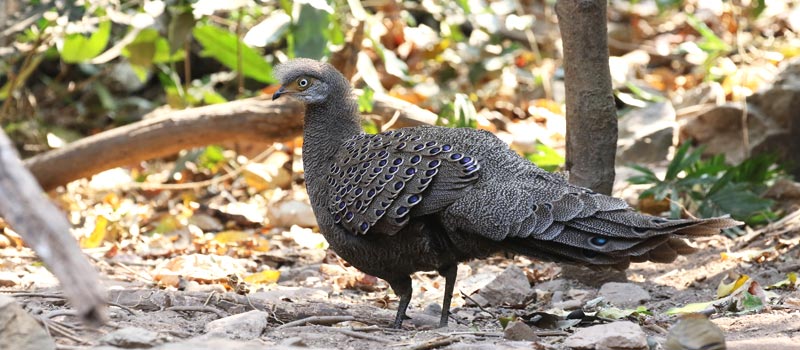
The garrulous laughingthrushes bouncing back and forth, the
gem-like male Black-naped Monarch dive-bombing the water,
squabbling bulbuls and iridescent Racket-tailed Treepie all
take your mind off of the fact that it is hot and humid in
the hide and that the chairs are not exactly designed for
sitting upon for long periods of time. Having enjoyed the
myriad of small birds that attend the waterholes and seen
them coming back again and again one might be tempted to call
it a day and go back to the accommodation for a shower and
some refreshment. However, if you wait quietly and allow the
commoner birds to become comfortable out in the open you might
be treated to the secretive Grey Peacock Pheasant slowly emerging
from the surrounding forest. This is a distinct possibility
at one or two of the hides in the area in dry periods that
force them to visit the waterhole to drink.
This has been a feature of the driest periods over the last
few years but before that seeing a Grey Peacock Pheasant relied
a lot more on good fortune. This is one of those birds which
is not particularly rare but it is shy and hard to observe.
For birders walking along the road through the national park
both the harsh call and rapid angry chicken-like clucking
can quickly become familiar but stalking one down is extremely
hard and they rarely come out into the open to respond to
call playback. Listen to the call of Grey
Peacock Pheasant.
Over the years quite a few birders have got lucky seeing Grey
Peacock Pheasant as it crosses the road in the upper reaches
of the national park, particularly when the males are displaying
to females in the early breeding season. From my experience
if there has been an afternoon rain shower this species can
sometimes be seen drying out in the middle of the road along
with Red Junglefowl or Kalij Pheasant. Conversely, if it has
been very dry then it can be worth waiting near puddles in
dried up stream beds to see if you get lucky.
The other location in Thailand where there are frequent sightings
of Grey Peacock Pheasant is Mae Wong National Park. Here there
is also a stakeout where rangers have provided food and these
strange birds have become habituated. Elsewhere I have heard
the call of this bird at Doi Lang and others have heard it
at a few other spots in Northern Thailand, but it does not
seem to be as common as it is at Kaeng Krachan anywhere else.
Red Junglefowl Gallus gallus
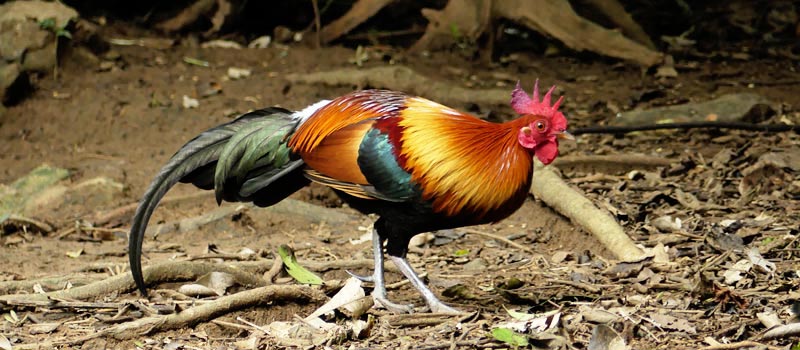
There have been occasions when I have been sitting in a hide
near Kaeng Krachan and few birds have arrived with the exception
of Red Junglefowl. In fact this is true to the point that
at times it has felt like sitting and watching a chicken farm
but one look at the most handsome males should make birders
realize that this species is far more than that. In fact if
we were not so familiar with domestic chickens the male Junglefowl
would be a very sought-after bird and perhaps even a highlight
of a birding trip in Thailand. In fact more than one birder
who has accompanied me to Kaeng Krachan has rated Red Junglefowl
in their top sightings.
Many birders get a kick out of hearing Red Junglefowl calling
in the forest in the morning. Of course it sounds just like
a male chicken crowing in the morning, you can listen to it
here - Red
Junglefowl call.
Red Junglefowl is seen at more or less all of the hides around
Kaeng Krachan National Park, sometimes in large groups, but
it is the mature males that are the most fantastic. This species
is often seen in the national park too when driving along
the road and is also frequently seen at Khao Yai National
Park, Doi Lang East, Mae Wong National Park and several other
sites. If you are staying at Baan Maka Nature Lodge then you
will probably see them from the restaurant as you eat breakfast
or lunch.
Kalij Pheasant Lophura leucomelanos
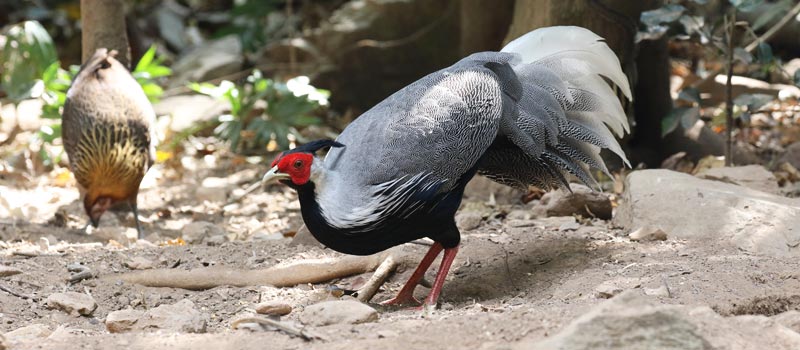
"What a bird, and the female is not too shabby either"
is a common response from birders when they first see this
handsome pheasant. Indeed, when the male begins to approach
from the dark forest it can often be seen through the leafy
foliage, its silvery plumage making it easier to spot than
the female. Similarly to Grey Peacock Pheasant before the
advent of the hides around the national park this species
was most regularly seen along the upper reaches of the road
through Kaeng Krachan, sometimes offering opportunities to
photograph it but now many birders are able to get the best
of views and superb photos at many of the hides. This species
is regular at the popular Lung Sin waterhole, Baan Song Nok,
Daap Waterhole, Neung waterhole and even in the grounds of
Baan Maka Nature Resort.
Kalij Pheasant does not seem to make any sound that could
be described as a call, the only sound I have ever heard from
it is a low but constant clucking as they feed in pairs. My
guess is that this is a contact call that they make to reassure
each other that everything is safe.
Birders who are familiar with Kalij Pheasant from Nepal and
India will note that this bird looks very different to the
individuals that occur there. The taxonomy of the birds in
Thailand have been under discussion over the years with this
taxon, crawfurdi, being considered a subspecies of
Silver Pheasant in some field guides. However, the most recent
lists and field guides deal with this and lineata
as Kalij Pheasant; it is my understanding that the genetics
of these Thai birds are closer to that of Kalij Pheasant than
Silver Pheasant. I think the phrase "closer to"
may indicate that in the future the taxonomy of these birds
could come under further scrutiny.
Kalij Pheasant is also quite frequently seen along the lower
and mid stretches of the road through Mae Wong National Park.
Crested Partridge Rollulus
rouloul
This incredible bird has been recorded at Kaeng Krachan but
I am not aware of any sightings in recent years. I heard the
call of this species on one occasion in about 2009 but never
again. There are a few sightings of Crested Partridge from
a couple of sites in Southern Thailand over the last ten years
but nowhere has it been seen on more than one occasion. I
have seen this wonderful partridge at Way Kambas National
Park in southern Sumatra, Indonesia, but if one should start
to visit any of the hides near Kaeng Krachan then you can
guarantee that there will be a long queue of photographers
wanting to visit.
Long-billed Partridge
Rhizothera longirostris
This is a rare bird wherever it occurs and has more or less
mythical status in Thailand. Roughly ten years ago there was
a conceivable tentative report of one at dusk near one of
the large water holes along the road at Kilometre 9 in Kaeng
Krachan National Park by an experienced birder who understood
how rare this bird is. The reporter was not 100% certain but
it was really only the rarity of the bird that gave him any
doubts.
I stumbled across a galliforme at Bala Wildlife Sanctuary
on the border with Malaysia, in 2012 that may have been Long-billed
Partridge. I was very close to the bird, however it ran away
quickly but the size, shape and colour were all right for
Long-billed Partridge. I am not certain but these are the
only two possible sightings that I am aware of in the last
twenty years. If Long-billed Partridge were to come to feed
at any of the Kaeng Krachan hides there will be a stampede
of birders.
Accommodation at Kaeng Krachan
For birders who want to see these and/or photograph these
birds for themselves, and a lot more besides, Baan
Maka Nature Lodge is a great place to stay. Not only do
they have some of these birds visiting the grounds they also
keep logs of what has been seen by their guests at the hides
that they visit. Staff at Baan Maka speak English and will
deal with making reservations for any of the hides/waterholes
that you might want to visit.
Samarn Bird Camp and Khum Nang Phaya are other options for
accommodation and both have their own hides that they run
and can also help birders arrange visits to the other hides
around the area.
Learn More
 For
birders that want to know more about the ecology and distribution
of the birds dealt with on this page then the book Pheasants,
Partridges and Grouse by Madge & McGowan is one of
those excellent volumes that summarizes the collective knowledge
into one place. As the title suggests it deals with all of
the Pheasants, Partridges and Grouse of the world. It also
includes Quail, Guineafowl, Buttonquail and Sandgrouse, over
250 species and all subspecies within the group. In these
books I always enjoy studying the species accounts, learning
about the birds but most of all I love looking at the range
maps and thinking about where to go to see as many of them
as possible. For
birders that want to know more about the ecology and distribution
of the birds dealt with on this page then the book Pheasants,
Partridges and Grouse by Madge & McGowan is one of
those excellent volumes that summarizes the collective knowledge
into one place. As the title suggests it deals with all of
the Pheasants, Partridges and Grouse of the world. It also
includes Quail, Guineafowl, Buttonquail and Sandgrouse, over
250 species and all subspecies within the group. In these
books I always enjoy studying the species accounts, learning
about the birds but most of all I love looking at the range
maps and thinking about where to go to see as many of them
as possible.
If you have any of the other titles in this series then this
is a good addition to your collection, dealing with some of
the world's most flamboyant birds.
|